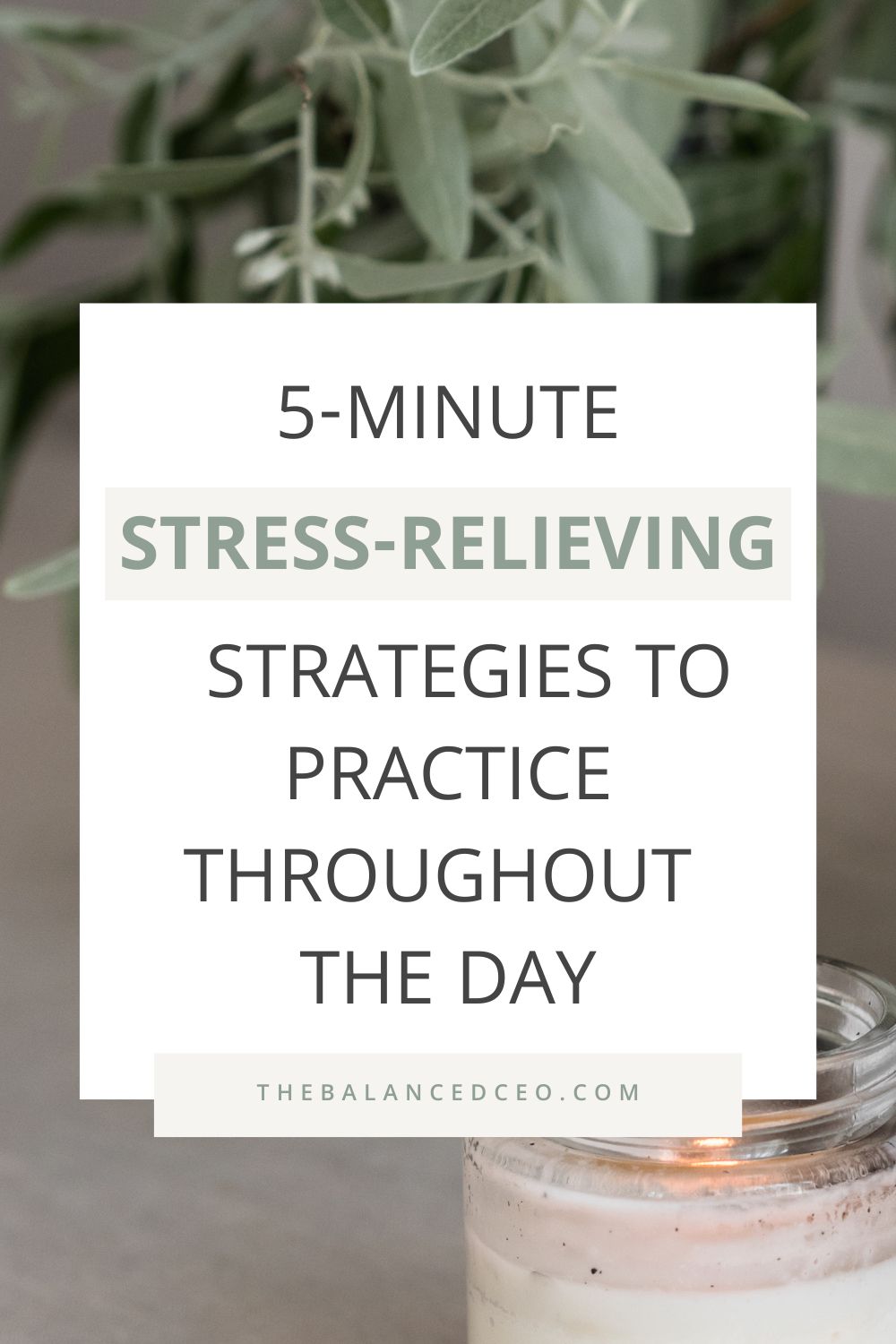This post may contain affiliate links, which means I’ll receive a commission if you purchase through my links, at no extra cost to you. Please read full disclosure for more information.

Mindfulness strengthens your psychological and even physical health. However, it is a practice — meaning you won’t get maximum benefits if you only engage once in a while. You must make it a part of your lifestyle to reap the most perks.
Fortunately, it doesn’t take very long at all — once you hone your skills, you can tap into mindfulness nearly anytime and anywhere.
Try these five-minute stress-relieving practices to practice throughout the day.
Stress-Relieving Strategies
1. Smile
The simple act of manipulating your facial expressions — with or without the accompanying emotion — can relieve stress throughout your day. In one study, participants used chopsticks to maneuver their faces into a Duchenne or genuine smile where the corners of their eyes crinkle. Those who did reported lower stress levels and increased positive emotions despite the manual impulse.
Find a place where you feel comfortable cracking a grin and concentrate on smiling. Start by taking a deep breath and heaving a sigh as you exhale, turning up the corners of your mouth and eyes. Focus on how your facial muscles feel and tune into any corresponding mood changes. It’s OK if you feel silly at first. You might even discover that negative emotions arise first — “why should I smile when I’m miserable” — before gradually improving.
This simple smiling exercise provides a bonus for folks with social anxiety, a condition affecting roughly 7% of the population. A pleasant facial expression makes you more approachable. You might not have to strike up conversations with strangers — they’ll come to you if you appear warm and welcoming.
Turning up your lip corners might even help you feel more relaxed at your company happy hour. Your nerves also carry messages from your muscles to your brain, and a smile tells your amygdala, “It’s OK. There’s no threat — I’m relaxed and happy.”
2. Savor a Treat
Did you know mindfulness can include a five-minute chocolate break? The tiny squares are the perfect amount for a treat that engages your senses, even providing a psychological boost thanks to the mood-enhancing properties of cocoa.
Slowly unwrap your chocolate, paying attention to the texture and color. Nibble and sniff your square before popping it in your mouth — are there any extra ingredients like salted caramel? Finally, let the treat dissolve on your tongue as you savor the sensation it creates in your mouth and tune into how your body reacts to this happy introduction.
Related Reads:
• 30 Journal Prompts for Stress and Anxiety
• 12 Simple Ways to Calm Your Anxious Mind
3. Stretch
Interoception deals with how your physical sensations affect your mental state. You might not realize your achy lower back is making you grumpy until you try to touch your toes and sigh in relief.
You don’t need more than five minutes for a quick stretch break. Start with a body scan to identify any areas that could use movement. If you simply need to restore the oxygen to your brain, a brief sun salutation or two stretches your entire body while nourishing your brain with a few deep breaths of fresh air.
4. Jam Out
Music has the power to heal. You know your mood instantly lifts when your favorite jam comes over the speakers. Why not harness the stress-relieving properties of song throughout your day?
All you have to do is find a place where you can dance and sing like no one’s watching — your car makes an excellent concert hall. Let the music move you. You might sip tea while listening to a relaxing jazz broadcast or play air guitar on your couch while jamming to death metal.
5. Get Back to Nature
Nature has magical curative powers, boosting everything from mood to immune function. Getting outside is the perfect way to practice mindfulness.
Step outdoors and enjoy the sun on your skin when the weather cooperates. Bask in the warmth. Can you feel your cells responding, producing more vitamin D and becoming more energized?
Take a mindfulness walk if you have more time. Focus on the sensation of your feet striking the ground as you stroll. How do your legs feel as they absorb the impact? Can you feel the muscles in your calves and thighs flex as they take each stride? Do you note your heart rate increases slightly as you build momentum?
6. Follow the Guide
Yoga is the ultimate mind-body exercise. However, you don’t have to go to an hour-and-a-half session at the studio — wouldn’t it be lovely to have that kind of daily time? Fortunately, you can squeeze in your practice as a series of five-minute stress-relieving stretches.
This ancient practice teaches you how to use your breath to get through difficulties. Many poses feel phenomenal, but you might find some that are downright uncomfortable. However, elongating your exhales helps you reap the benefits while minimizing strain.
Fortunately, you can find various yoga styles to suit every fitness level. Five minutes of energetic Ashtanga-vinyasa-style sun salutations raise your heart rate and work nearly every muscle. Gentle yin stretches work deeper into connective tissues and fibers, often without requiring you to get off the floor.
7. Make a List
The human mind tends to ruminate on the negative. This propensity makes evolutionary sense. Your primitive ancestors had to carefully note past hazards to keep from encountering them again to stay alive. Once a leopard pounces from a jackalberry tree, it’s natural to eye similar shrubbery with suspicion.
However, this can cause psychological harm in the modern world, leaving you rueful over a past you can’t change and a boatload of regret. It’s far healthier to shift your focus to the positive, reminding yourself that at least you’re at least not looking over your shoulder at every jackalberry tree.
The solution is to keep a gratitude journal and make writing in it one of your daily five-minute stress-relieving practices. This exercise requires you to focus on the good in your life, shifting your vibe and making you happier.
8. Engage Your Senses
Those with a trauma history know that telling yourself to “calm down” amid a panic attack often backfires. Your HPA axis is activated, and various neurotransmitters and hormones are going nuts. Then, you pile on the stress of invalidation. “Oh, c’mon, there’s nothing to be upset about,” you say when your physiology is retorting, “Oh, yes, there is.”
Instead, use this five-minute stress-relieving practice. Stop where you are and list five things you can see. Then, progress to four you can feel and three you can hear, finishing with two you can smell and one you can taste.
This exercise takes you out of spiraling future fears or past ruminations and grounds you in the present. It helps to breathe deeply while performing this practice, elongating your exhales to activate your parasympathetic nervous system’s calming effect.
Strategies to Soothe Your Stress
Today’s hectic pace of life can leave you feeling frazzled. Mindfulness can help, and you don’t have to spend hours in meditation to reap the benefits.
Improve your mental and physical health with these eight five-minute stress-relieving strategies to practice throughout the day. You’ll experience greater inner peace and increase your overall well-being.

Cora Gold
Contributor
Cora Gold is the Editor-in-Chief of Revivalist magazine, a publication dedicated to happy, healthy, and mindful living.





Leave a Reply